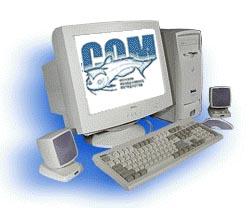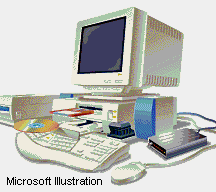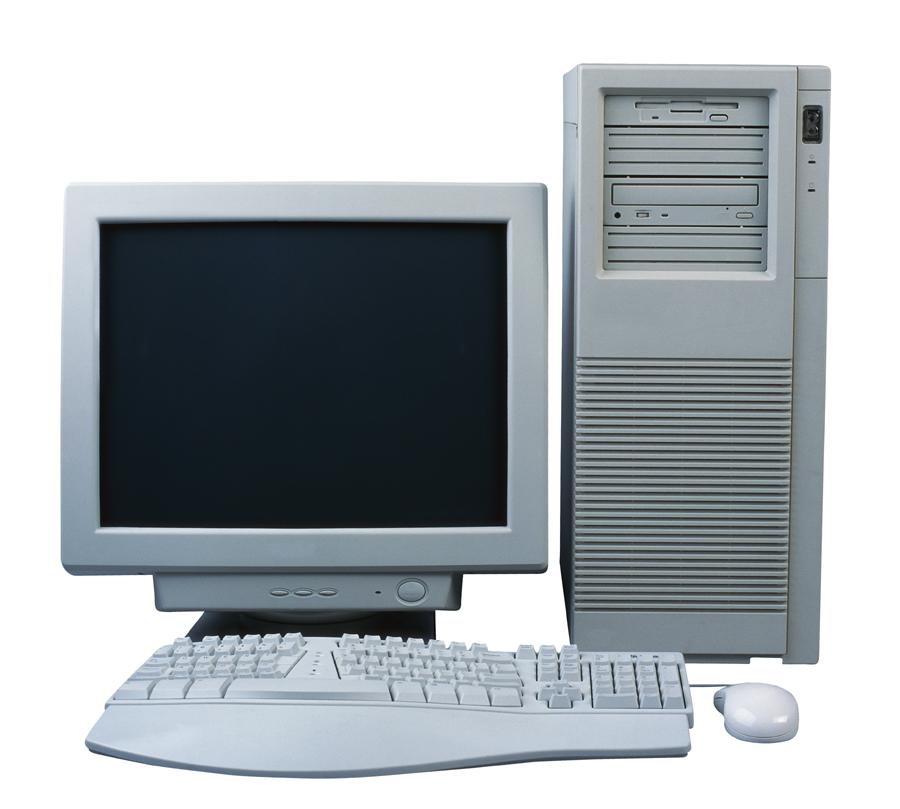
- •Unit 1 computer applications
- •Computers
- •What can computers do?
- •Unit 2 computer essentials
- •What is a computer?
- •Unit 3 inside the system
- •What’s inside a pc system?
- •Structure of the processor
- •Unit 4 bits and bites
- •Units of memory
- •Unit 5 magnetic drives
- •Technical details
- •Unit 6 optical breakthrough
- •Optical disks and drives
- •Iomega's removable drives
- •Unit 7 input / output devices
- •Voice recording device h. Keyboard
- •Unit 8 capture your favourite image
- •Vivid easy-to-use faster fashionable wide shots
- •Unit 9 viewing the output
- •The monitor
- •Unit 10 choosing a printer
- •Types of printers
- •Unit 11 operating systems Exercise 1.Look at the diagram below. What is the function of the operating system?
- •Exercise 4. Language work
- •Unit 12 the graphical user interface
- •Unit 13 a walk through word processing
- •Word-processing facilities
- •Unit 14 spreadsheets
- •Unit 15 databases
- •Basic features of database programs
- •Exercise 6. Writing
- •Unit 16 faces of the internet
- •Exercise 2. Maybe we can find it on the Internet.
- •Exercise 3. Reading.
- •Internet software
- •Irc, audio and video chatting
- •MIrc for Windows is a typical Internet relay chat program. You can get it at http://www.Mirc.Co.Uk/
- •Unit 17 programming and languages
- •Programs and programming languages
- •Exercise 3. These are answers to questions about the text. Write the questions.
- •Variables and the Declaration Statement
- •Unit 18 computer networks
- •Computer networks
- •Network configurations
- •4 Bus/Ethernet
- •Unit 19 computer viruses
- •How computer viruses work
- •Unit 20 computers in the office
- •Information systems
- •Using Computers
- •Information Technology (it)
- •Exercise 5. Link each statement (1-) with a purpose (a-j).
- •Exercise 6. Match the words from the box with their definitions.
- •The future? We’re virtually there!
Structure of the processor
The processor consists of a 1_____ , which is a circuit board on which are mounted 2_____ chips, memory chips, and other components linked together by 3_____ lines or channels in the form of control, address, and data 4_____. In addition, a processor has 5_____, which are electronic circuits providing specialized functions such as graphics, or which connect a system board to 6_____.The system board also consists of electronic devices, such as an electronic 7_____ for controlling the speed of operation; 8_____, which store numeric data during the course of processing; and various 9_____, including sequence control register, address register, and function register.
Exercise 7. Vocabulary quiz.
In groups of three, write answers to these questions. The winners are the group that answers the most questions correctly in four minutes.
What are the main parts of the CPU?
What is RAM?
What memory section is permanent and contains instructions needed by the CPU?
What information is lost when the computer is switched off?
What is the typical unit used to measure RAM memory and storage memory?
What is the meaning of the acronym SIMM?
What is a megahertz?
What is the ALU? What does it do?
What is the abbreviation for 'binary digit'?
How can we store data and programs permanently?
Exercise 8. Your ideal computer system.
A Make notes about the features of the computer that you would like to have.
CPU: ............... Speed: ............... Optical disk drives: ...............
Minimum/maximum RAM: ............... Monitor: ...............
Hard disk: ............... Software: ...............
B Now describe it to your partner.
Useful expressions
It has got... The hard disk can hold...
It's very fast. It runs at... As for the Internet...
The standard RAM memory... and it is expandable
I need a SuperVGA monitor because ...
Unit 4 bits and bites
Exercise 1. With a partner, try to answer these questions.
How many digits does a binary system use? What is a 'bit'?
What is the difference between binary notation and the decimal system? Give some examples.
What is a collection of eight bits called?
One kilobyte (IK) equals 1,024 bytes.
Can you work out the value of these units? (kilo-: one thousand)
1 megabyte =___ bytes/1,024 kilobytes (mega-: one million)
1 gigabyte = ___bytes/1,024 megabytes (giga-: one thousand million)
What does the acronym 'ASC II' stand for? What is the purpose of this code?
Now read the text to check your answers or to find the correct answer.
Units of memory
Bits – basic units of memory
Information is processed and stored in computers as electrical signals. A computer contains thousands of electronic circuits connected by switches that can only be in one of two possible states: ON (the current is flowing through the wire) or OFF (the current is not flowing through the wire). To represent these two conditions we use binary notation in which 1 means ON and 0 means OFF. This is the only way a computer can 'understand' anything. Everything about computers is based upon this binary process. Each 1 or 0 is called a binary digit or bit.
Bytes and characters
1s and Os are grouped into eight-digit codes -that typically represent characters (letters, numbers and symbols). Eight bits together are called a byte. Thus, each character in a keyboard has its own arrangement of eight bits. For example, 01000001 for the letter A, 01000010 for B and 01000011 for C.
The ASCII code
The majority of computers use a standard system for the binary representa-
tion of characters. This is the American Standard Code for Information Interchange, known popularly as 'ASC II' (pronounced 'ask-key'). There are 256 different ways of combining 0, and 1 bits in a byte. So they can give us 256 different signals. However, the ASC II code only uses 128 bytes to represent characters. The rest of the bytes are used for other purposes.
The first 32 codes are reserved for characters such as the Return key, Tab, Escape, etc. Each letter of the alphabet, and many symbols (such as punctuation marks), as well as the ten numbers, have ASCII representations. What makes this system powerful is that these codes are standard.
Kilobytes, megabytes and gigabytes
In order to avoid astronomical figures and sums in the calculation of bytes, we use units such as kilobytes, megabytes and gigabytes. One kilobyte is 1,024 bytes (210) and it is represented as KB, or more informally as K. One megabyte is equivalent to 1,024 KB, and one gigabyte is 1,024 MB.
We use these units (KB, MB, GB) to describe the RAM memory, the storage capacity of disks and the size of any application or document.
Exercise 2. Look at the illustrations and the captions below.
Then fill in the blanks with the correct unit of memory.

|
1 One _____ represents one character. |
2 One _____ represents 1,024 characters (about a small page of text). |
3 One _____ represents 1,000,000 characters (about the text of this book). |
4 One _____ represents 1,000,000,000 characters (about 1,000 books in a library). |
Exercise 3. Word building.
A The table gives some prefixes commonly used in computer science. Knowing the meaning of these prefixes will help you understand new words.
|
Prefix |
Meaning |
Examples |
|
deci- hexadeci- kilo-
mega- giga-
mini- micro- bi- tri- multi- mono- |
ten sixteen one thousand (1,000) (1,024 in binary: 210) large ;one million very large; one thousand million small very small two three many one |
decimal, decimalize, decibel hexadecimal kilocycle, kilogram(me), kilowatt
megahertz, megalith, megaton gigantic, gigabyte, gigahertz
minibus, minimum, minimize microfilm, microphone, microwave bidirectional, bidimensional, binary tripartite, tricycle, trilingual multi-racial, multi-user, multitasking monologue, monosyllable, monolingual |
B Explain these expressions, taking into account the prefixes and root word.
Example: the binary system
The binary system is a notation which uses two digits, 0 and 1.
a minicomputer 6 a bidimensional chessboard
a microcomputer 7 a tricycle
the decimal system 8 a monochrome computer
the hexadecimal system 9 a CPU with 256 MB of RAM
a multi-user configuration 10 a document of 3 kilobytes
Exercise 4. Bits for pictures.
A Read the questions and text and study the diagrams.
Did you know that...
bits can also be used to code pictures?
the information displayed on the computer screen corresponds, dot by dot, with bits held in the main memory?
on colour systems, if you have 8 bits per primary colour, the palette of your computer can obtain 16.7 million colours?
Each tiny dot on the screen of a computer is called a picture element or pixel. Images and text are formed by combining a large number of pixels.
In a bit-mapped display, the dots displayed on the screen correspond, pixel by pixel, with bits in the main memory of the computer. The bits are held in an area of the memory called the 'refresh buffer' and are stored in groups, that represent the horizontal and vertical position of the pixels on the screen and whether the pixels are on or off.
O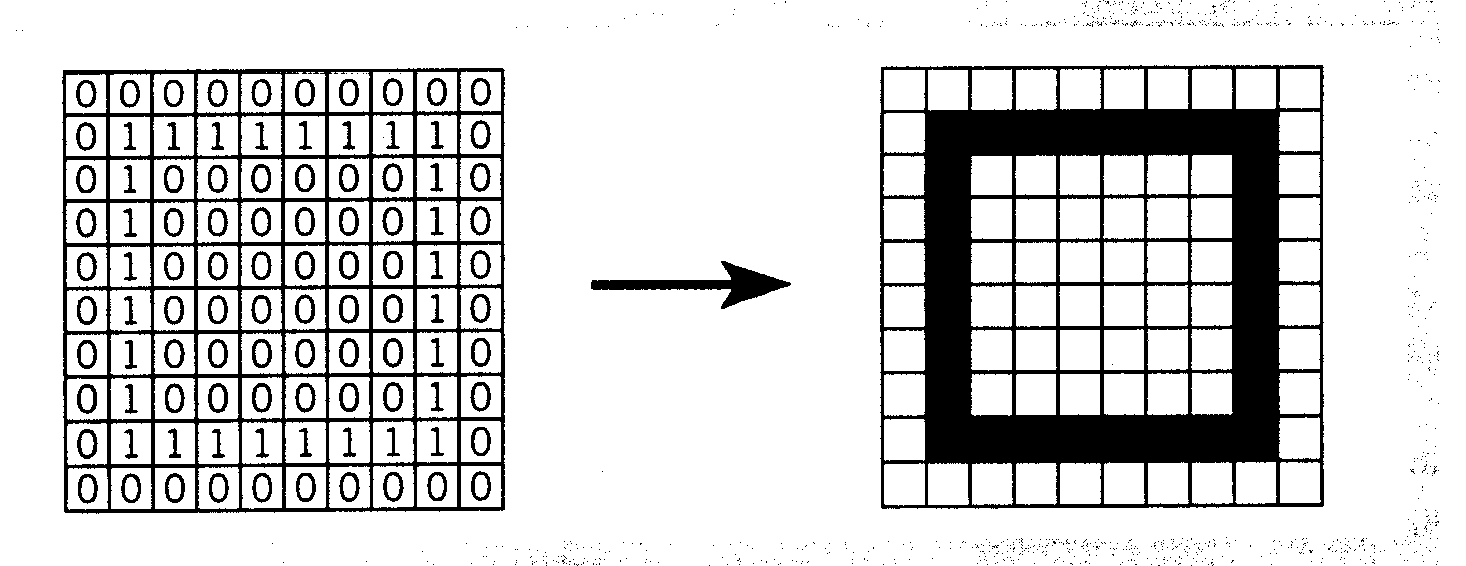 n
monochrome systems, one bit in this 'map' represents one pixel on the
screen and can be either 'on' or 'off' (black or white).
n
monochrome systems, one bit in this 'map' represents one pixel on the
screen and can be either 'on' or 'off' (black or white).
Refresh buffer (memory} Display
On colour systems, each pixel is a certain combination of the three primary colours: red, green and blue. The total number of colours which can be shown on the screen is called the colour palette. The size of this palette depends on the graphics adaptor, a separate video card that converts the bits into visual signals. A graphics adaptor with 1 bit per primary colour can generate up to 8, or 23, colours, as you can see from the table. A graphics adaptor with 8 bits per primary colour can generate 16.7 million or (23)8 colours.
|
Colour |
Red |
Green |
Blue |
|
black |
0 |
0 |
0 |
|
blue |
0 |
0 |
1 |
|
green |
0 |
1 |
1 |
|
cyan |
0 |
1 |
1 |
|
red |
1 |
0 |
0 |
|
magenta |
1 |
0 |
1 |
|
yellow |
1 |
1 |
0 |
|
white |
1 |
1 |
1 |
One bit per primary colour
B Using the information in the passage and the illustrations, match the terms in the box with the appropriate explanation or definition.
a pixel b bit c bit-mapped display
d primary colours e palette
The menu of colours available on a graphics system; its size depends on the hardware.
Red, green and blue (RGB) in computers.
The smallest element of a display surface.
A display on the screen which corresponds, pixel by pixel, with bits stored in memory cells.
The acronym for 'binary digit'; one of the digits (0 and 1) used in binary notation.
C Translate the last paragraph (starting from 'On colour systems, ...') into Ukrainian.
Do you understand the calculations made to obtain a palette of 16.7 million colours? (If you don't, ask a partner to explain them to you.)
Exercise 5. Buying a computer
Name eight different items you can buy in a computer shop.
Work with a partner. One of you wants to buy a computer, the other is the sales assistant. Ask and answer questions, using the information and instructions below to help you.
|
Products available |
Processor Speed |
Minimum/ Maximum RAM |
Hard disk |
Disk drives |
Monitor |
Price |
|
Explora 700 Net PC |
Mips R4700 900MHz |
128 MB expandable to 512 |
20GB |
Optional 3.5" drive |
Super VGA compatible |
£799 |
|
Toshiba portable
|
Pentium 4 1.5 Ghz |
256 MB expandable to 512 |
40GB |
3.5" drive DVD/ CD-RW
|
colour LCD |
£2.309 |
|
IBM |
Pentium 4 1.8 GHz
|
256 MB expandable to 512 |
70GB |
DVD CD-RW |
XGA |
£2.149 |
|
Polywell |
AMD Athlon 1.6 GHz |
512 Mb expandable to 2GB |
80GB |
3.5" drive DVD/ CD-RW |
SuperVGA |
£2.700 |
|
Dell |
Pentium 4 2 GHz |
256 MB expandable to 1 GB |
60GB |
DVD/ CD-RW |
XGA |
£2.710 |
Shop assistant Customer
Greet the customer and offer help.
Ask to see some computers.
Show the customer some models.
Ask for details: processor, RAM, etc.
Describe the speed in megahertz and the main memory.
Ask about the hard disk.
Give explanations (GB storage capacity, etc.).
Ask about the monitor and other features.
Give the required information.
Ask the price.
Give the price and explain different ways of paying.
Decide to buy one/to think about it.
Thank the shop assistant and leave the shop
Exercise 6. Read the description of the four people and the four computers below. With a partner choose the most suitable computer for each person. Give reasons for your choices.
Daniel is a history student. He needs a computer to write essays, assignments and letters. He likes surfing the web.
Sarah is the manager of art advertising company. She needs a powerful system which will work with optical disks and multimedia applications, integrating text and pictures with animation and voice annotations. Digitized images and sound occupy a lot of disk space.
Andy is a CAD engineer. His job involves computer-aided design, simulations and three-dimensional modelling. These applications require a lot of memory and a large drive.
Tanya is a sales representative. She needs a lightweight machine with which she can process orders and communicate with head office white she is on the road.
|
|
|
|
Sun workstation |
Compaq Presario PC |
CPUs)
|
|
|
|
|
|
Compaq Evo Notebook N200 |
Compaq Presario PC |
|
|
Exercise 7. Vocabulary tree
Designing vocabulary trees or networks can help you build up your own mental 'maps' of vocabulary areas. Look at the list of terms in the box and put each one in an appropriate place on the vocabulary tree below. The first one has been done for you.
processor kilobyte expandable memory
megahertz SIMMs hard disk
RAM computer brain byte
DVD clock speed keyboard
mouse gigahertz CD-ROM
megabyte floppy disk registers
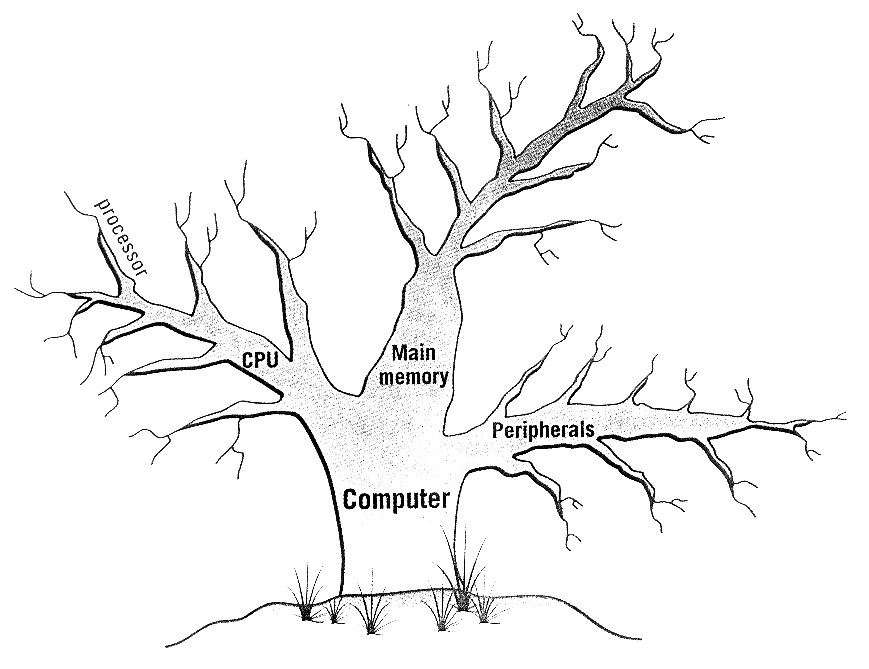
Exercise 8. Writing.
A friend has written to you asking you to recommend a computer that suits his/her needs. Write a letter in reply, describing its technical features and saying why you recommend it.

